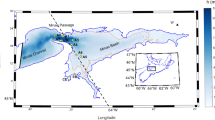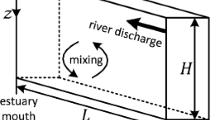Abstract
The effect of pulsed events on estuarine turbidity maxima (ETM) was investigated with the Princeton Ocean Model, a three-dimensional hydrodynamic model. The theoretical model was adapted to a straight-channel estuary and enhanced with sediment transport, erosion, deposition, and burial components. Wind and river pulse scenarios from the numerical model were compared to field observations before and after river pulse and wind events in upper Chesapeake Bay. Numerical studies and field observations demonstrated that the salt front and ETM had rapid and nonlinear responses to short-term pulses in river flow and wind. Although increases and decreases in river flow caused down-estuary and up-estuary (respectively) movements of the salt front, the effect of increased river flow was more pronounced than that of decreased river flow. Along-channel wind events also elicited non-linear responses. The salt front moved in the opposite direction of wind stress, shifting up-estuary in response to down-estuary winds and vice-versa.
Modeled pulsed events affected suspended sediment distributions by modifying the location of the salt front, near-bottom shear stress, and the location of bottom sediment in relation to stratification within the salt front. Bottom sediment accumulated near the convergent zone at the tip of the salt front, but lagged behind the rapid response of the salt front during wind events. While increases in river flow and along-channel winds resulted in sediment transport down-estuary, only reductions in river flow resulted in consistent up-estuary movement of bottom sediment. Model predictions suggest that wind and river pulse events significantly influence salt front structure and circulation patterns, and have an important role in the transport of sediment in upper estuaries.
Similar content being viewed by others
Literature Cited
Bennett, W. A., W. J. Kimmerer, andJ. R. Burau. 2002. Plasticity in the vertical migration by native and exotic estuarine fishes in a dynamic low-salinity zone.Limnology and Oceanography 47: 1496–1507.
Biggs, R. B. 1970. Sources and distribution of suspended sediment in northern Chesapeake Bay.Marine Geology 9:187–201.
Blumberg, A. F. andG. L. Mellor. 1987. A description of a three-dimensional coastal ocean circulation model, p. 1–16.In N. Heaps (ed.), Three-Dimensional Coastal Ocean Models, Volume 4. American Geophysical Union, Washington, D.C.
Boynton, W. R., W. Boicourt, S. Brant, J. Hagy, L. Harding, E. Houde, D. V. Holliday, M. Jech, W. M. Kemp, C. Lascara, S. D. Leach, A. P. Madden, M. Roman, L. Sanford, andE. M. Smith. 1997. Interactions between physics and biology in the estuarine turbidity maximum (ETM) of Chesapeake Bay, USA.International Council for the Exploration of the Sea CM 1997/S:11.
Brenon, I. andP. Le Hir. 1999. Modelling the turbidity maximum on the Seine estuary (France): Identification of formation processes.Estuarine, Coastal and Shelf Science 49:525–544
Burchard, H. andH. Baumert. 1998. The formation of estuarine turbidity maxima due to density effects in the salt wedge. A hydrodynamic process study.Journal of Physical Oceanography 28:309–321.
Cancino, L. andR. Neves. 1999a. Hydrodynamic and sediment suspension modelling in estuarine systems Part I: Description of numerical models.Journal of Marine Systems 22:105–116.
Cancino, L. andR. Neves. 1999b. Hydrodynamic and sediment suspension modelling in estuarine systems. Part II: Application to the western Scheldt and Gironde estuaries.Journal of Marine Systems 22:117–131.
Colman, S. M., J. P. Halka, andC. H. Hobbs, III. 1992. Patterns and rates of sedimentation in the Chesapeake Bay during the Holocene rise in sea level, p. 110–111.In C. H. Fletcher and J. F. Wehmiller (eds.), Quaternary Coasts of the United States: Marine and Lacustrine Systems. Special Publication No. 48. Society for Sedimentary Geology, Tulsa, Oklahoma.
Dodson, J. J., J. -C. Dauvin, R. G. Ingram, andB. D'Anglejan. 1989. Abundance of larval rainbow smelt (Osmerus mordax) in relation to the maximum turbidity zone and associated macroplanktonic fauna of the middle St. Lawrence estuary.Estuaries 12:66–81.
Eisma, D., P. Bernard, G. C. Cadee, V. Ittekkot, R. Laane, J. M. Martin, W. G. Mook, A. Van Put, T. Schuhmacher, andJ. Kalf. 1991. Suspended-matter particle size in some west-European estuaries: Part 1: Particle-size distribution.Netherlands Journal of Sea Research 28:193–214.
Elliott, A. J. 1978. Observations of the meteorologically induced circulation in the Potomac estuary.Estuarine and Coastal Marine Science 6:285–299.
Elliott, A. J., D.-P. Wang, andD. W. Pritchard. 1978. The circulation near the head of Chesapeake Bay.Journal of Marine Research 36:643–655.
Fain, A. M. V., D. A. Jay, D. J. Wilson, P. M. Orton, andA. M. Baptista. 2001. Seasonal and tidal monthly patterns of particulate matter dynamics in the Columbia River estuary.Estuaries 24:770–786.
Festa, J. F. andD. V. Hansen. 1978. Turbidity maxima in partially mixed estuaries: A two-dimensional numerical model.Estuarine, Coastal and Marine Science 7:347–359.
Friedrichs, C. T., B. D. Armbrust, andH. E. de Swart. 1998. Hydrodynamics and equilibrium sediment dynamics of shallow, funnel-shaped tidal estuaries, p. 315–328.In J. Dronkers and M. Scheffers (eds.), Physics of Estuaries and Coastal Seas. Balkema Press, Rotterdam, The Netherlands.
Garvine, R. W. 1999. Penetration of buoyant coastal discharge onto the continental shelf: A numerical model experiment.Journal of Physical Oceanography 29:1892–1909.
Garvine, R. W. 2001. The impact of model configuration in studies of buoyant coastal discharge.Journal of Marine Research 59:193–225.
Geyer, W. R. 1993. The importance of suppression of turbulence by stratification on the estuarine turbidity maximum.Estuaries 16:113–125.
Geyer, W. R. 1997. Influence of wind on dynamics and flushing of shallow estuaries.Estuarine, Coastal and Shelf Science 44:713–722.
Geyer, W. R., R. P. Signell, andG. C. Kineke. 1998. Lateral trapping of sediment in a partially mixed estuary, p. 115–124.In J. Dronkers and M. Sheffers (eds.), Physics of Estuaries and Coastal Seas. Balkema Press, Rotterdam, The Netherlands.
Geyer, W. R., J. D. Woodruff, andP. Traykovski. 2001. Sediment transport and trapping in the Hudson River estuary.Estuaries 24:670–679.
Glangeaud, L. 1938. Transport et sédimentation dans l'estuaire et a l'embouchure de la Gironde. Caracteres Petrographiques des Formations Fluviatiles, Saumatres, Littordes, et Néritiques.Bulletin of Geological Society of France 8:599–630.
Grabemann, I. andG. Krause. 2001. On different time scales of suspended matter dynamics in the Weser estuary.Estuaries 24:688–698.
Jassby, A. D., W. J. Kimmerer, S. G. Monismith, C. Armor, J. E. Cloern, T. M. Powell, J. R. Schubel, andT. J. Vendlinski. 1995. Isohaline position as a habitat indicator for estuarine populations.Ecological Applications 5:272–289.
Jay, D. A. andJ. D. Musiak. 1994. Particle trapping in estuarine tidal flows.Journal of Geophysical Research 99:20,445–20,461.
Kappenberg, J. andI. Grabemann. 2001. Variability of the mixing zones and estuarine turbidity maxima in the Elbe and Weser estuaries.Estuaries 24:699–706.
Kimmerer, W. J., J. R. Burau, andW. A. Bennett. 1998. Tidally oriented vertical migration and position maintenance of zoo-plankton in a temperature estuary.Limnology and Oceanography 43:1697–1709.
Krone, R. B. 1962. Flume studies of the transport in estuarine shoaling processes. Hydraulic Engineering Laboratory, University of Berkeley. California.
Mellor, G. L. 1998. User's Guide for a Three-Dimensional, Primitive Equation, Numerical Ocean Model. Program in Atmospheric and Ocean Sciences, Princeton University, New Jersey.
Mellor, G. L. andT. Yamada. 1974. A hierarchy of turbulence closure models for planetary boundary layers.Journal of Atmospheric Science 31:1791–1806.
Munk, W. H. andE. R. Anderson. 1948. Notes on a theory of the thermocline.Jouranl of Marine Research 7:276–295.
Noble, M. A., W. W. Schroeder, W. J. Wiseman, Jr.,H. F. Ryan, andG. Gelfenbaum. 1996. Subtidal circulation patterns in a shallow, highly stratified estuary: Mobile Bay, Alabama.Journal of Geophysical Research 101:25,689–25,703.
North, E. W. andE. D. Houde. 2001. Retention of white perch and striped bass larvae: Biological-physical interactions in Chesapeake Bay estuarine turbidity maximum.Estuaries 24: 756–769.
Postma, H. andK. Kalle. 1955. Die Entstehung von Trübungszonen im Unterlauf der Flüsse, speziell im Hinblick auf die Verhaltnisse in der Unterelbe.Deutsche Hydrographische Zeitschrift 8:137–144.
Roman, M. R., D. V. Holliday, andL. P. Sanford. 2001. Temporal and spatial patterns of zooplankton in the Chesapeake Bay turbidity maximum.Marine Ecology Progress Series 213:215–227.
Sanford, L. P., W. Panageotou, andJ. P. Halka. 1991. Tidal resuspension of sediments in northern Chesapeake Bay.Marine Geology 97:87–103.
Sanford, L. P., S. E. Suttles, andJ. P. Halka. 2001. Reconsidering the physics of the Chesapeake Bay estuarine turbidity maximum.Estuaries 24:655–669.
Schubel, J. R. 1968. Turbidity maximum of the northern Chesapeake Bay.Science 161:1013–1015.
Schubel, J. R. andD. W. Pritchard. 1986. Responses of the upper Chesapeake Bay to variations in discharge of the Susquehanna River.Estuaries 9:236–249.
Simenstad, C. A., C. A. Morgan, J. R. Cordell, andJ. A. Baross. 1994. Flux, passive retention, and active residence of zooplankton in Columbia River estuarine turbidity maxima, p. 473–482.In K. R. Dyer and R. J. Orth (eds.), Changes in Fluxes in Estuaries: Implications from Science to Management. Olsen and Olsen, Fredensborg, Denmark.
Sirois, P. andJ. J. Dodson. 2000. Influence of turbidity, food density and parasites on the ingestion and growth of larval rainbow smeltOsmerus mordax in an estuarine turbidity maximum.Marine Ecology Progress Series 193:167–179.
Uncles, R. J. andJ. A. Stephens. 1993. The freshwater-saltwater interface and its relationship to the turbidity maximum in the Tamar estuary, United Kingdom.Estuaries 16:126–141.
Wang, D. P.. 1979. Wind-driven circulation in the Chesapeake Bay, Winter, 1975.Journal of Physical Oceanography 9:564–572.
Wang, H. V. C. andS.-Y. Chao. 1996. Intensification of subtidal surface currents over a deep channel in the upper Chesapeake Bay.Estuarine, Coastal and Shelf Science 42:771–785.
Weisberg, R. H. 1976. The nontidal flow in the Providence River of Narragansett Bay: A stochastic approach to estuarine circulation.Journal of Physical Oceanography 6:721–734.
Source of Unpublished Materials
BITMAX program (Bio-physical Interactions in the Turbidity Maximum). website:www.BITMAX.org
Author information
Authors and Affiliations
Corresponding author
Rights and permissions
About this article
Cite this article
North, E.W., Chao, S.Y., Sanford, L.P. et al. The influence of wind and river pulses on an estuarine turbidity maximum: Numerical studies and field observations in Chesapeake Bay. Estuaries 27, 132–146 (2004). https://doi.org/10.1007/BF02803567
Received:
Revised:
Accepted:
Issue Date:
DOI: https://doi.org/10.1007/BF02803567




